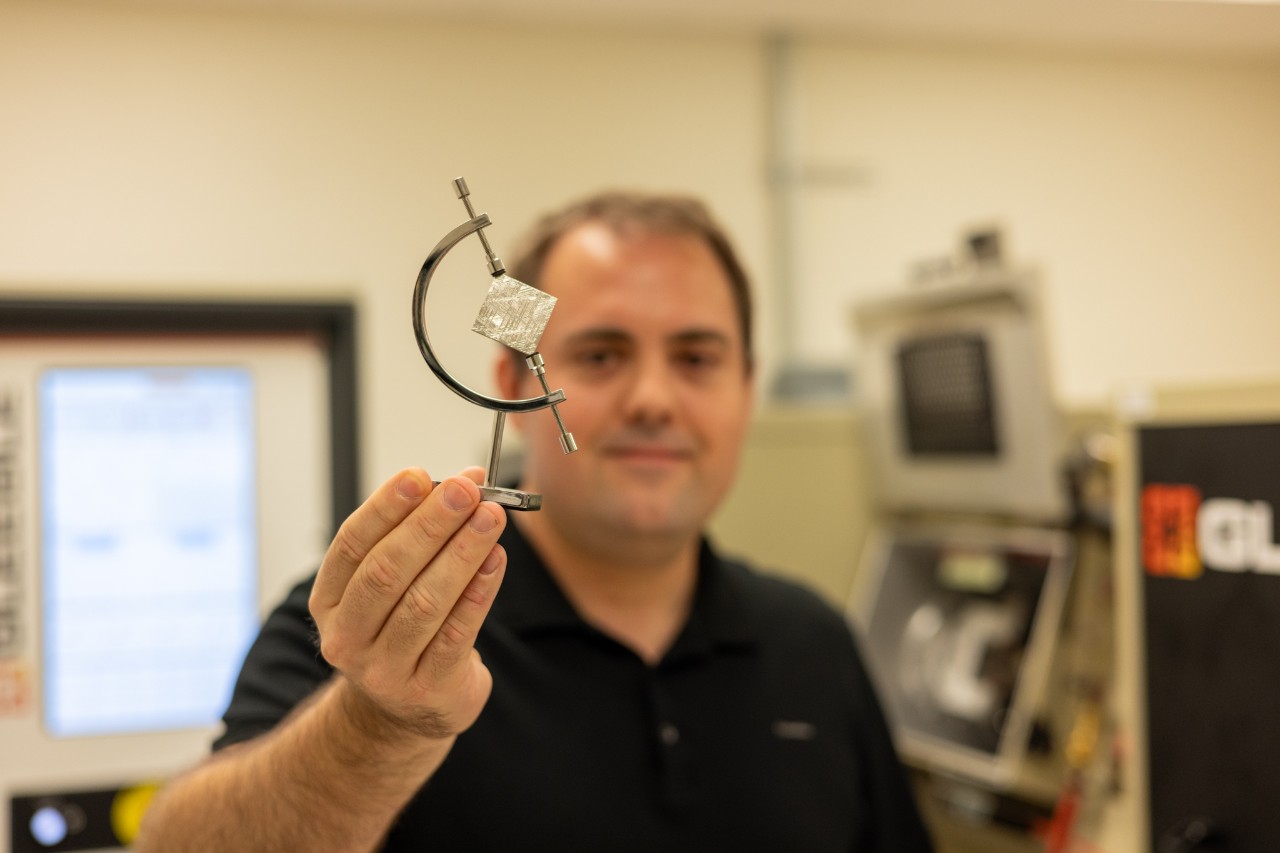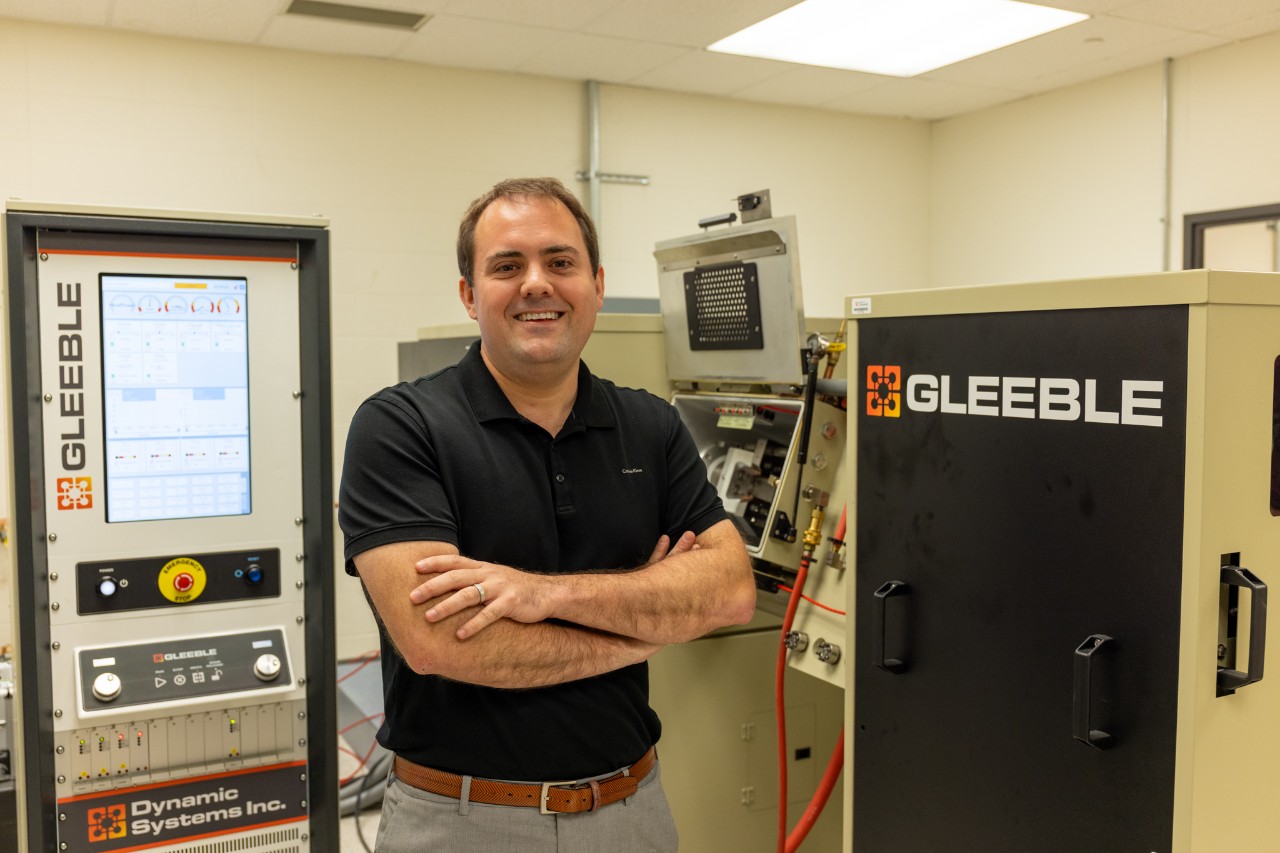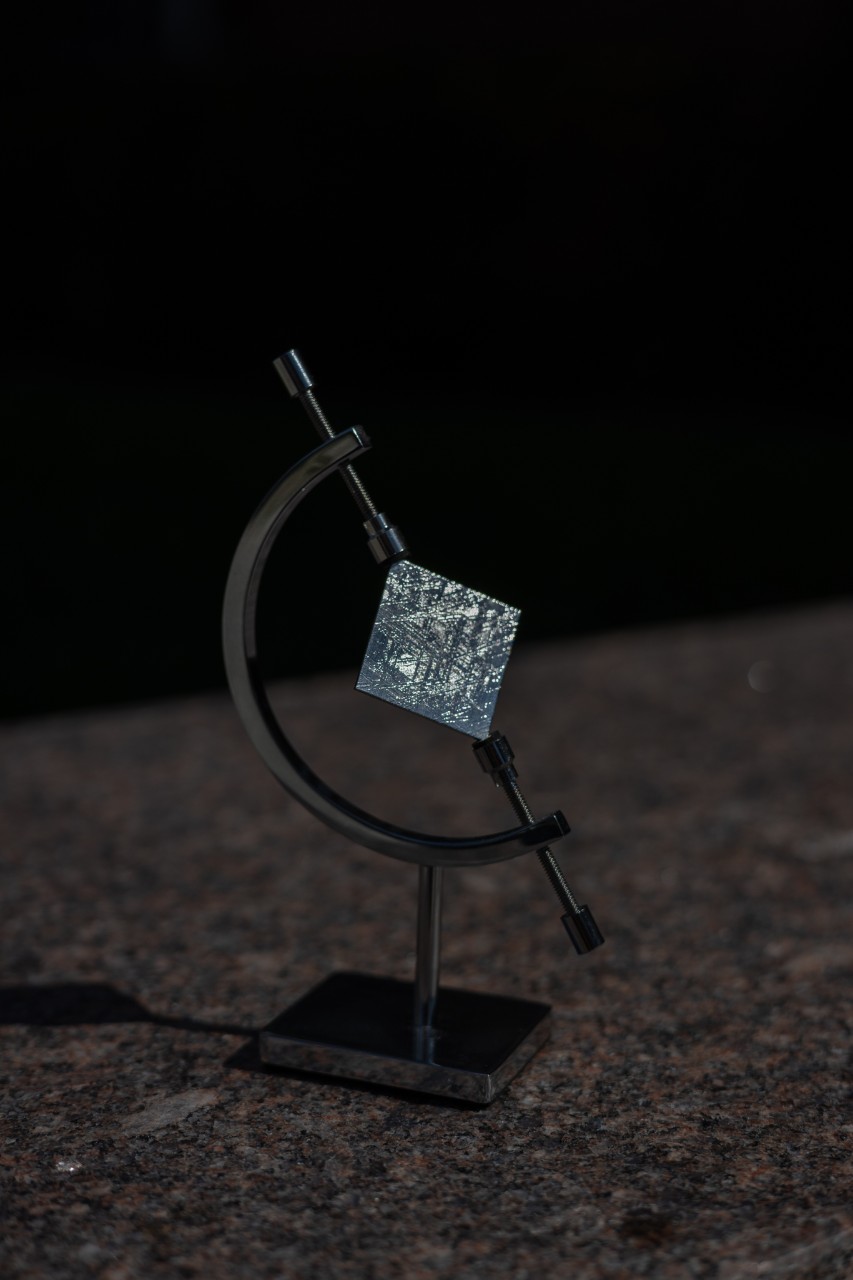
UC engineer explores better materials for clean energy solutions
Metals physicist awarded DoE Early Career grant to develop sustainable magnets for electric vehicles
As the world embraces sustainable transportation and clean energy, researchers at the University of Cincinnati are trying to solve the challenges of these growing technologies. Innovations like electric vehicles and wind turbines rely on high-strength permanent magnets to operate, but the scarcity of rare-earth elements in these magnets poses a significant obstacle.
Matt Steiner, assistant professor of materials science and engineering at UC’s College of Engineering and Applied Science (CEAS), is working to solve a piece of the puzzle that could lead to the development of more accessible alternative magnets.

Matt Steiner in his lab. Photo/Corrie Mayer/CEAS Marketing
“In materials science, we are always thinking about supply-limited materials,” Steiner said. “For example, in car batteries, lithium and cobalt are very supply limited. It’s one of the reasons why electrifying things has been such a challenge, because these low supply materials put a strain on the whole system.”
Steiner’s lab is focusing on the science behind the creation of a special type of iron-nickel magnet, called tetrataenite. Tetrataenite is the perfect replacement for the rare-earth magnets currently used in EVs and wind turbines because the materials are relatively abundant and have the necessary magnetic properties. However, it takes the atoms in iron-nickel millions of years to properly diffuse and become the ideal magnet. Steiner and his team are testing strategies to drastically accelerate this process in the lab to create this super-strong magnet in bulk for use in clean energy technologies.

A piece of a meteorite containing tetrataenite. Photo/Corrie Mayer/CEAS Marketing
When iron and nickel are melted and cast, the atoms start out in a jumble but eventually end up in what Steiner calls a “layer cake structure,” with a layer of iron alternating with a layer of nickel, and so on, which is the configuration required to rival the rare-earth magnets currently in use.
“The atoms are eventually going to order themselves the way we want, but we are exploring methods to encourage them to get there faster,” Steiner said. “So instead of millions of years, we can try and encourage it to happen in weeks or days.”
Scientists first discovered this tetrataenite layer-cake structure in meteorites over 50 years ago — Steiner keeps one in his lab for inspiration — and researchers have been trying to replicate its properties on Earth ever since.
Steiner received the prestigious Department of Energy Early Career Research Award in 2023, granting him $875,000 to continue this research project over the next five years.
While earning his bachelor’s in applied physics from Columbia University and his PhD from the University of Virginia in Charlottesville, Steiner developed an affinity for science that had more direct applications rather than more mathematical ones. During his undergraduate years, Steiner discovered an interest in physics, specifically nuclear and plasma physics, which set him on the trajectory leading him to where he is today. Now, through this DoE research grant, he hopes to share that inspiration and drive for direct scientific application with the next generation of students.
“This grant provides me the luxury to be able to sit down for five years with a PhD student to really focus on the work that we do, and it provides our students with opportunities that they otherwise may not have had before,” Steiner said.
In addition to his iron-nickel magnet research, Steiner is the primary adviser to four graduate students and has three undergraduate students that work in his lab. Recently, Steiner also completed research projects evaluating steel corrosion in bridges, sensitization of marine aluminum alloys, developing new nickel-based alloys for high temperature applications and analyzing uranium nuclear fuel alloys. He graduated his first PhD student this October.
“I’m hoping, if nothing else, that all of the work I do with my students establishes that materials science is a growing interdisciplinary field that is vital to our collective success in the world of science. A lot of people look at things like metallurgy as sort of dead fields, when they’re really not,” Steiner said.
Steiner is also honored to be a vital part of putting UC onto bigger stages in the research world. Steiner, along with Annette Rowe from biological sciences, was one of two professors from UC who received the Department of Energy grant this year. The Department of Energy only gives around 50 of these grants to university researchers every year, making Steiner’s award particularly noteworthy.
“As materials scientists, we are constantly researching and producing parts and materials that are vital to everything we need, from driving to manufacturing to flying. Our graduates have a high job placement rate because there are so many exciting and diverse applications for materials science that most people just aren’t exposed to at the college level. It’s important for people to know how important the work that we do is. I’m excited to keep pushing our knowledge further alongside my students over the next five years.”
Featured image at top: In his lab, Matt Steiner, assistant professor of materials science and engineering, holds an inspirational meteorite piece. Photo/Corrie Mayer/CEAS Marketing
Learn more about CEAS
Discover the research and academic advantages at the College of Engineering and Applied Science.
Related Stories
What computers tell us about synthetic biology
March 3, 2022
Creating synthetic life could be easily within our grasp soon based on a comparison with the evolution of computer chips. Computer programming and gene synthesis appear to share little in common. But according to University of Cincinnati professor Andrew Steckl, an Ohio Eminent Scholar, leaps forward in technology in the former make him optimistic that wide scale gene manufacture is achievable.
‘Everything is made out of something’
July 5, 2023
Ashley Paz y Puente is an assistant professor of materials engineering at the University of Cincinnati College of Engineering and Applied Science. Supported by the prestigious National Science Foundation CAREER grant she was awarded in 2022, Paz y Puente is researching how to create stronger and lighter weight materials that could be applied to almost everything we use in our daily lives. She is seeking to better understand the Kirkendall effect in the process of diffusion.
P&G, UC celebrate partnership that accelerates innovation
March 22, 2023
As UC and P&G build on their partnership, they have renamed and celebrated the P&G Digital Accelerator @ The University of Cincinnati.
UC engineer explores better materials for clean energy solutions
November 1, 2023
Matt Steiner, assistant professor of materials science and engineering at UC’s College of Engineering and Applied Science (CEAS), is working to solve a piece of the puzzle that could lead to the development of more accessible alternative magnets. Steiner received the prestigious Department of Energy Early Career Research Award in 2023, granting him $875,000 to continue this research project over the next five years.
UC adds master's degree in sustainable energy engineering
August 7, 2023
The University of Cincinnati launched a new Master of Engineering degree program in Sustainable Energy, designed to equip future leaders with the expertise and skills needed to tackle the pressing global challenges of climate change and sustainable energy supply.
Engineering professor develops on-demand drug delivery
July 28, 2021
Yoonjee Park, assistant professor of chemical engineering at University of Cincinnati's College of Engineering and Applied Science, developed a biodegradable drug delivery device that is activated by light, which would allow for on-demand dosing and fewer side effects for treatment of posterior eye diseases. With recent funding awards from the National Institute of Health and a Young Investigator Award from Ohio Lions Eye Research Foundation, Park and her research team are testing the safety and efficacy of the device. In 2019, she also participated in UC’s Venture Lab business pre-accelerator.
Digital Fabrication Lab aids pandemic response
January 11, 2021
The University of Cincinnati's Digital Fabrication Lab fired up its 35 3D printers to help create products to help early in the pandemic. The projects were just a few of the 60,000 printed parts produced by the lab for UC engineering and medical students and faculty researchers and for external sources like the Cincinnati Museum Center.
UC’s AI innovations at work
August 7, 2023
Here at the University of Cincinnati, researchers are employing AI to gather and analyze data, to better understand human behavior and to create simulations for improved predictions. They also are seeking to improve AI decision-making, and they’re creating programs to help students and faculty harness AI for good.
Lawmaker visits UC to learn about microchip manufacturing
May 28, 2024
U.S. Rep. Greg Landsman, D-Cincinnati, toured the clean room at the University of Cincinnati to learn more about how students are preparing to join Ohio’s growing high-tech industries.
Engineering student makes sense of waves
July 9, 2021
When Parikshit Boregowda, mechanical engineering doctoral student at the University of Cincinnati, is staring at ocean waves crashing into the shore, he’s thinking about the problems he can solve through better modelling methods to study the motion of fluid.
